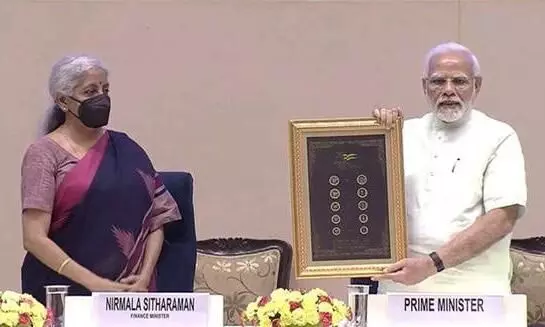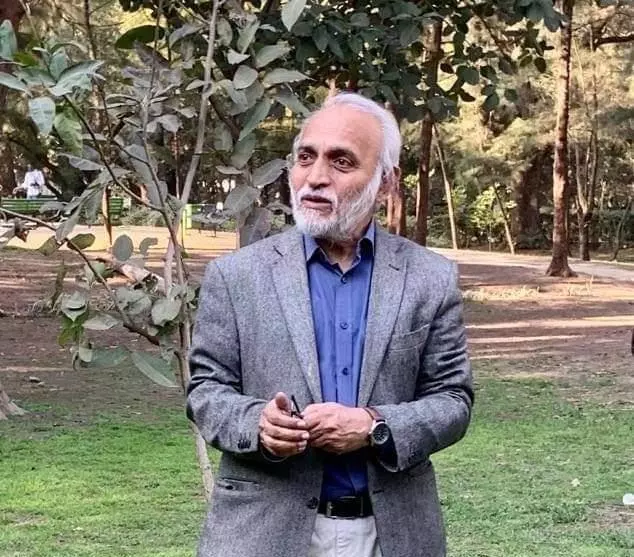Economy trundles despite 2-digit growth, while Modi govt busy with politics
Nirmala Sitharaman is in a complacent mood that India remains the fastest growing economy though the 7.7 per cent GDP growth rate projected for 2022-23

Finance Minister Nirmala Sitharaman is in a complacent mood that India remains the fastest growing economy though the 7.7 per cent GDP growth rate projected for 2022-23 is not good enough for India to create new jobs and bring cheer to the people and to the investors.
But then the government of Prime Minister Narendra Modi cannot be expected to bother about the economy. The Bharatiya Janata Party (BJP) is into the election mode, with the cycle of Assembly elections starting from Gujarat and Himachal Pradesh at year-end and going into important state elections of Rajasthan, Madhya Pradesh, Karnataka, Chhattisgarh, and towards the end of 2023, Telangana.
For Prime Minister Modi and the BJP, fighting and winning elections is both a passion and obsession. Nothing else matters. So, the economy will go on autopilot, and everyone from the Union cabinet ministers to the RSS volunteer will get into the mud-pit of campaigning. If there is a national agenda, then it will be geared towards elections. But the BJP leaders are sure to flaunt the fact of the fastest growing economy, which is a fact and if you ignore the context it can be seen as an achievement, and the fact that due to statistical juggling India is now the fifth largest economy in the world overtaking England will be used in the elections, but not as much as the divisive Hindu-Muslim agenda. So, the economy will literally be put on backburner from now till the Lok Sabha elections of 2024.
It is against this political background we need to look at the national economic scene.
GDP growth falls short of projected rate
There has been discreet silence in the government quarters about the 13.5 GDP growth in the First Quarter (Q1) of 2022-23. It has fallen short of the 16.2 per cent projected by the Reserve Bank of India (RBI). The growth in Q1 of 2021-22 was 20.1 per cent compared to the precipitous fall in the same period in 2020-21 Q1, when it fell to minus 24.4 per cent during the stringent nationwide Covid lockdown in April-May 2020. The 2021-22 figure of Q1 GDP growth of 20.1 was seen in the context of the previous low.
The double-digit growth is positive, but it shows that some key sectors like manufacturing are not doing well enough, which lingered at 4.8 per cent, slightly ahead of agriculture at 4.5 per cent. The services sector comprising trade, hotels, transport, communications and services related to broadcasting contributed 25.7 per cent in the growth push. The government share, including GST and non-GST tax revenues accounted for 26.3 per cent, while its expenditure was reined at 11.9 per cent. It is the private final consumption expenditure of 59.9 per cent that is the engine of growth. But the catch is that unless there is job creation there would not be private consumption.
And the Periodic Labour Force Survey (PLFS) numbers which the government had started from April 2017, show that it is not a happy situation. The April-June 2022 figure for Labour Force Participation Rate (LFPR) based on Current Weekly Status (CWS) in urban areas is 47.5 per cent, with huge gap between employed urban males standing at 73.5 per cent, and that of employed women at 20.9 per cent. And the Worker Population Ratio (WPR) figures are much sharper. For April-June 2022, for urban areas, the figure is 43.9 per cent, with women accounting for 18.9 per cent and the figure for male employment standing at 63.8 per cent.
If the April-June 2022 GDP growth figures are juxtaposed with Periodic Labour Force Survey figures for the same period, it becomes evident that there is the problem that more than half the people who are eligible to work are out of work. The PLFS WPR figure of 43.9 per cent is quite dismal. It gives an indication of the rate of unemployment. It is indeed the case that the government cannot provide employment, and the private sector, including in the services, is not able to absorb the unemployed unless the economy picks up. The fact that India is the fastest growing economy in the world cannot be a matter of pride and solace because there are challenges on hand.
The inflation rate as indicated by the Consumer Price Index (CPI) is hovering above 5 per cent, though below the upper limit of 6 per cent. Inflation for July 2022 stood at 5.78 per cent, while food inflation is at 5.96 per cent.
It is a tight situation if not grim. There is no glimmer of hope of things easing up in the next two quarters either because across the world central banks are raising interest rates to tame inflation. The Reserve Bank of India (RBI) too had felt the need to change its position from 'accommodative' and it is looking to raise the interest rates. This could dampen the speed of growth.
The United States Federal Reserve Chairman Jeremy Powell is clear in his mind that he would sacrifice prospects of growth to keep inflation in check.
For the last two years, the RBI had adopted a stance of supporting growth, but it may not be able to maintain the balancing act. Government should indeed be worried. And perhaps it is, though it is hiding the concerns and anxieties behind the bureaucratic mask.
The lurking hope is that there is pent-up demand of a section of the middle class and that this could drive growth in the second half of the 2022-23 financial year (FY) seems reasonable enough.
This would need reasonable salary and wage increases, and fresh hirings. The Information Technology (IT) sector seems set for a hiring bash. But it is the manufacturing sector that must do its bit. And the services sector, including hospitality and tourism can do lot more as people begin to move out, and the foreign tourists could come back in large numbers. There can be initiatives from government, but it is the animal spirits of the private sector players that will revive the economy. The government is unwilling to spend because it thinks that it will land the government in trouble in the long term. It says it will help people by providing guarantees for bank loans. The people cannot look to Prime Minister Narendra Modi or Finance Minister Nirmala Sitharaman for any useful interventions. They have adopted a hands-off policy. The people must fend for themselves. And of course, pay through their noses the GST on all their economic transactions. The government will dutifully collect the GST dues and declare with glee the increase in the tax kitty.



